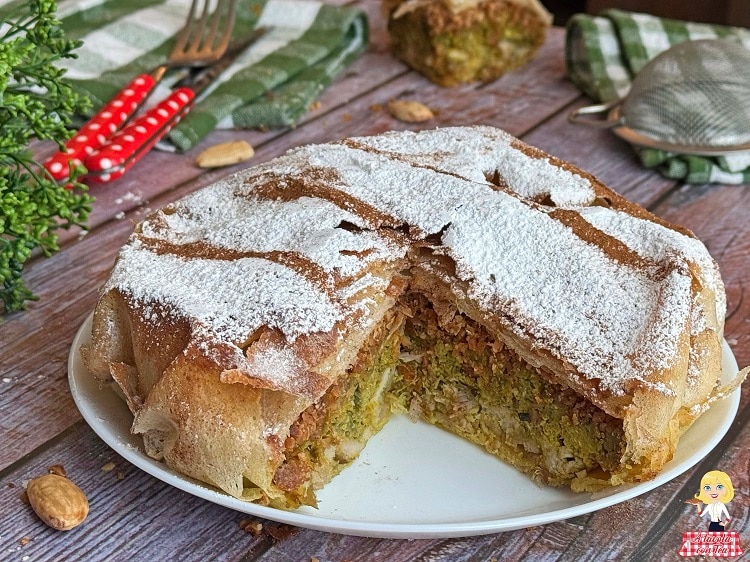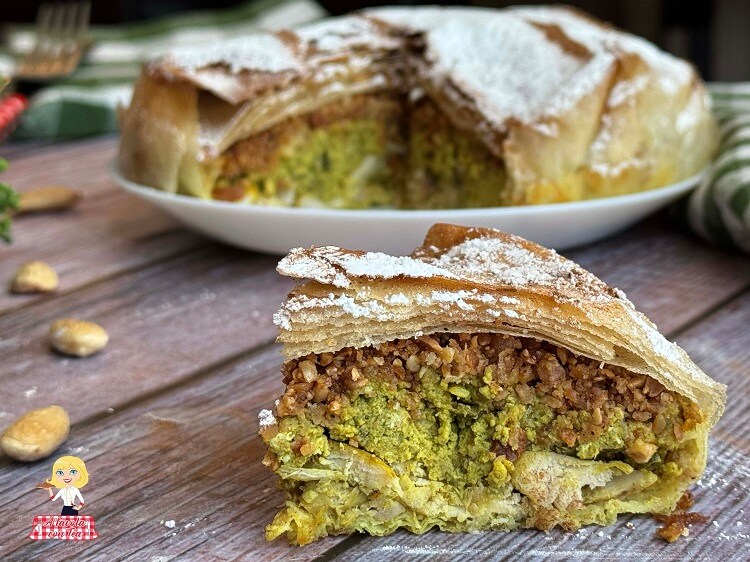Moroccan Chicken Pastilla A Sweet and Spicy Explosion that Enchants the Senses
Immerse yourself in an unforgettable culinary experience with Chicken Pastilla, an iconic Moroccan savory pie that seduces the palate with its bold and fascinating combination of sweet and savory flavors.
A symphony of textures ranging from the crispness of the pastry to the softness of the filling, and an intoxicating aroma of exotic spices that evoke the vibrant atmospheres of Marrakech.
Traditionally served as an appetizer on special occasions and celebrations, Pastilla is much more than a simple dish: it is a sensory journey that transports you straight to the heart of Morocco’s rich and millennial culinary tradition.
Indeed, thin layers of phyllo dough, light and crispy, envelop a rich and flavorful filling of tender chicken meat enriched by a velvety and slightly sweet sauce, obtained from the caramelization of onions and the addition of fresh eggs.
But the real surprise that makes Pastilla so unique is the layer of toasted and chopped almonds, flavored with cinnamon that provides a pleasant crunch and a contrast of flavors in every bite.
Serve it as traditionally done in Morocco with a generous dusting of powdered sugar and cinnamon stripes, a final touch that seals the sweet and savory harmony of this emblematic dish.
So get ready to delight your guests with Chicken Pastilla, a culinary experience that will leave an indelible mark on their palate and memory.

- Difficulty: Easy
- Cost: Medium
- Preparation time: 40 Minutes
- Portions: 6
- Cooking methods: Stovetop, Oven
- Cuisine: Moroccan
- Energy 568.36 (Kcal)
- Carbohydrates 28.74 (g) of which sugars 3.08 (g)
- Proteins 31.70 (g)
- Fat 36.95 (g) of which saturated 13.79 (g)of which unsaturated 22.36 (g)
- Fibers 3.29 (g)
- Sodium 358.87 (mg)
Indicative values for a portion of 200 g processed in an automated way starting from the nutritional information available on the CREA* and FoodData Central** databases. It is not food and / or nutritional advice.
* CREATES Food and Nutrition Research Center: https://www.crea.gov.it/alimenti-e-nutrizione https://www.alimentinutrizione.it ** U.S. Department of Agriculture, Agricultural Research Service. FoodData Central, 2019. https://fdc.nal.usda.gov
Ingredients
- 9 oz phyllo dough
- butter (for brushing)
- as needed powdered sugar (for final decoration)
- ground cinnamon (for final decoration)
- 1 chicken (pieces about 1.5 lbs)
- 3 eggs
- 5 tbsp butter
- 1 bunch parsley
- 1 1/2 tsp fresh ginger
- 2 ground cinnamon
- 1 tbsp granulated sugar
- 1 tsp ground turmeric
- 2 onions
- 1 packet saffron
- as needed salt
- 1 pinch black pepper
- 3.5 oz almonds
- 1 tbsp powdered sugar
- 1/2 tsp orange blossom aroma
- 1 tsp ground cinnamon
- as needed extra virgin olive oil
Tools
- Pot
- Skimmer
- Bowl
- Pan
- Mixer
- Casserole
- Sugar Sifter
Procedure for Moroccan Chicken Pastilla
Cut the chicken into pieces (thighs, drumsticks, breast). In a large pot, place the chicken pieces and add the spices: ground ginger, ground black pepper, ground turmeric, saffron (threads or powder), and salt. Completely cover the chicken with a mix of water and broth (about 2 cups water and 2 cups broth). Bring to a boil, then lower the heat and let simmer gently for about 25 minutes, stirring occasionally.
Add the finely chopped onion, butter pieces, and chopped fresh parsley to the chicken. Gently stir with a spoon, cover the pot with a lid, and continue cooking for another 20 minutes or until the chicken is tender and easily shreds. If the cooking liquid dries out too much, add some water or broth.
Once cooked, drain the chicken from the pot with a skimmer, reserving the cooking liquid. Debone the chicken, removing skin and cartilage, then shred the meat by hand. Set the shredded meat aside to cool completely. Important: All filling ingredients must be cold before assembling.
Return the pot with the chicken’s cooking liquid to the stove on low heat. Reduce the liquid until it thickens and the water nearly completely evaporates. Add granulated sugar and ground cinnamon and caramelize the onions in the cooking liquid, stirring gently. Separately, in a bowl, quickly beat the eggs with a fork. Pour the beaten eggs into the pot with the caramelized onions. Stir vigorously and continue cooking for a couple of minutes, until the liquid part has set, forming a creamy and homogeneous mixture.
In a small pan, heat a drizzle of extra virgin olive oil. Add the slivered or coarsely chopped almonds and toast them over medium heat until golden and fragrant (alternatively, you can toast them in a preheated oven). Remove the almonds from the pan and transfer them to a mixer along with the powdered sugar, ground cinnamon, and orange blossom water. Briefly blend until you obtain a coarse grain.
Thoroughly butter a round baking pan (approximately 9.5 inches in diameter). Place two sheets of phyllo dough, previously brushed with melted butter, on the bottom of the pan, overlapping so the edges hang over the pan. These edges will be folded to seal the pastilla.
Evenly distribute a layer of the creamy egg and onion mixture on the phyllo sheets. Cover with another buttered phyllo sheet. Create a second layer with the shredded chicken (ensure it is completely cold) and cover again with a buttered phyllo sheet. Finish with a final layer of almond grain.
Gently fold the edges of the phyllo sheets that extend beyond the pan inward to completely cover the filling. Place one last buttered phyllo sheet in the center of the pie and fold the edges inward to seal everything well. Brush the surface of the pastilla with more melted butter.
Bake the pastilla in a preheated oven at 356°F (convection) or 374°F (static) for about 30 minutes, or until the surface is golden and crispy.
Once baked, let the pastilla cool completely before serving. At serving time, generously dust the surface with powdered sugar and ground cinnamon.

Notes and Ingredient Substitutions
Phyllo Dough: Replaces the traditional “warka,” which is hard to find. Be sure to handle it gently and keep it covered with a damp cloth to prevent it from drying out. Brick pastry can be another alternative.
Chicken: Traditionally, pigeon is used. Chicken is a more common and easily obtainable alternative. You can use thighs, drumsticks, or breasts, or a mix.
Spices: The recipe includes a mix of typical spices. Traditional “ras el hanout” is complex (about 30 aromas). The suggested substitution (ginger, saffron, coriander, paprika) aims to replicate some of the aromatic notes. If you find it, you can use a good ras el hanout.
Butter: Used for cooking the chicken and for greasing the phyllo dough. You can also use seed oil, but butter gives a richer flavor.
Eggs: Used to thicken the chicken cooking liquid, creating a creamy sauce.
Almonds: Should be toasted to enhance their flavor and crunchiness. You can use slivered or chopped almonds.
Orange Blossom Water: Adds a delicate fragrance to the almonds. If you can’t find it, you can omit it or use a little bitter almond essence with great caution.
Sugar: Used both in the egg and onion filling and for the almond filling and the final dusting.
Cinnamon: A key spice in the flavor of the pastilla, used both in the filling and the topping and for the final dusting.
Parsley: Adds freshness to the chicken during cooking. You can substitute it with fresh cilantro if you prefer.
Saffron: Gives color and a particular aroma to the chicken. You can use either threads or powder.
CHICKEN PASTILLA VARIANTS
1 Seafood Pastilla: A less common but fascinating variant replaces chicken with a rich filling of mixed seafood (shrimp, squid, mussels) cooked with spices and parsley. The sweet part can be accentuated by adding raisins. Indicative quantities: About 1.1 lbs of mixed seafood.
2 Mini Pastillas: Instead of a large pie, single portions can be prepared using smaller molds. Cooking times may be slightly reduced. Quantities: Adjust the amount of ingredients based on the desired number of mini pastillas.
3 Vegetarian Pastilla (reinterpretation): Although not traditional, a vegetarian version could be created with a filling of mixed vegetables (pumpkin, carrots, onions) cooked with typical spices and a layer of dried fruit (walnuts, pistachios) instead of almonds. Indicative quantities: About 1.5 lbs of mixed vegetables.
4 Sweet Pastilla (Mhancha): There is a sweet version of the pastilla, called “Mhancha” or “Snake Cake,” filled with almonds, sugar, cinnamon, and orange blossom water, rolled into a spiral shape. Quantities: Similar to the almond filling of the savory pastilla, but without the chicken and with a larger amount of sugar.
STORAGE
Chicken Pastilla is best enjoyed freshly made, when the phyllo dough is still crisp and the filling is warm and flavorful. However, leftovers can be stored in the refrigerator, well covered, for a maximum of 2-3 days. It’s advisable to gently reheat it in the oven to try to revive the crispness of the pastry, even though it may not return perfectly as freshly made. Avoid reheating it in the microwave, as the phyllo dough would tend to soften. Pastilla does not freeze well, as the texture of the pastry and filling might alter once thawed.
STORIES AND ORIGINS RECIPE
The origins of Pastilla date back to Islamic Spain. When Muslims fleeing from Granada sought refuge in Africa, they brought their culinary traditions with them. Originally, it was a sort of pie made with pigeon meat, which over time was replaced with more common chicken meat. The meat was sautéed and then cooked in broth with ras el hanout, a typical Moroccan blend of about 30 aromas. Since ras el hanout is hard to find in Italy, it can be replaced with a mix of ginger, saffron, coriander, and paprika. The traditional pastry used is warka, extremely thin homemade sheets, which can also be replaced with phyllo or brick pastry due to its hard-to-find nature.

